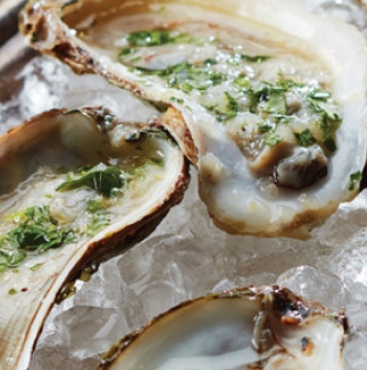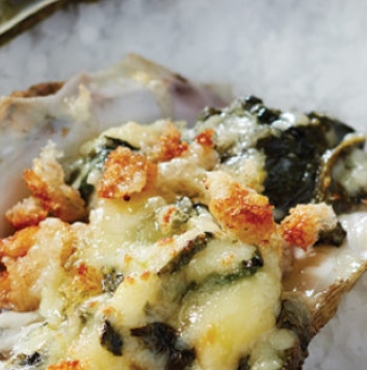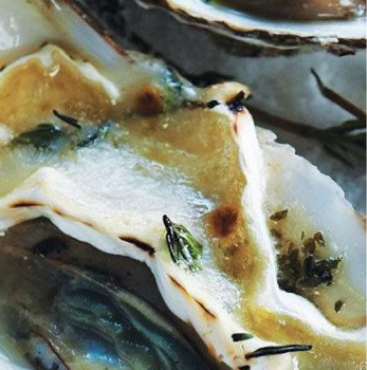Oysters have long been considered a delicacy, known for their unique texture and fresh, salty taste that transports you straight to the ocean.
In this guide, we are breaking down everything you need to know about oysters. From how to shuck them like a pro to the different flavour profiles you can expect. Whether you’re a seafood lover or a curious first-timer, our handy tips will help you make the most of your oyster experience.
How to shuck oysters
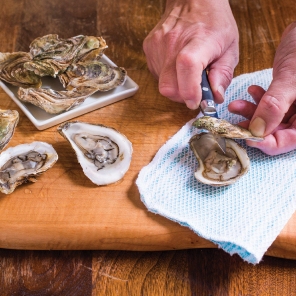
Shucking oysters can seem tricky at first but with the right tools and technique, it becomes much easier. Follow these simple steps for shucking oysters:
- Prepare your tools:You’ll need an oyster knife and a thick towel or oyster-shucking glove to protect your hand.
- Position the oyster:Wrap the oyster in a towel or wear a glove on the hand holding the oyster. Hold the oyster with the cup side down, making sure the hinge end is pointing towards you.
- Pry open the oyster:Gently work the tip of the knife into the hinge, angling the blade down into the cup of the oyster. Once the knife is in, twist it like you’re turning a key until you hear the hinge pop.
- Cut the muscle:Run the knife along the top inside of the shell to cut the adductor muscle. Lift the top shell away and discard.
- Loosen the oyster:Slide the knife underneath the oyster to loosen it from the shell. Settle the bottom of each shell onto a bed of crushed ice and serve immediately.
What are oysters served with?
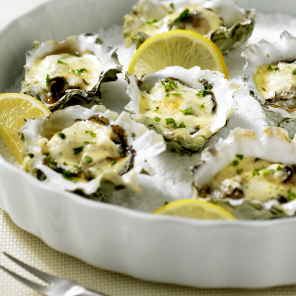
Oysters are often served with a variety of accompaniments that subtly help enhance their natural flavours. Some of the most popular items served with oysters include:
- Lemon wedges: This is a classic pairing. The acidity of fresh lemon juice cuts through the richness of oysters, adding a brightness that helps enhance their fresh, salty flavour.
- Mignonette sauce: This simple sauce made from vinegar, shallots and black pepper gives a tangy contrast to the oysters’ brininess.
- Hot sauce: For those who enjoy a bit of heat, hot sauce adds a spicy kick to the oysters.
- Cocktail sauce: This popular option combines ketchup and horseradish for a sweet, spicy and tangy hit.
Different types of oysters
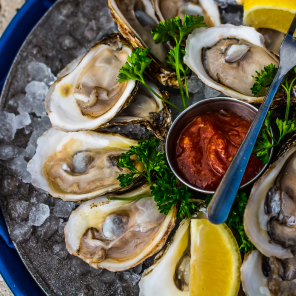
- Irish Point Oysters, Rustico Harbour, PEI: Irish Point is known for their mild and slightly sweet brine with plump meat and a smooth mineral finish.
- ShinySea Oysters, New London Bay, PEI: ShinySea oyster cups are usually full, with plump meats that are briny and fresh with a subtle sweet finish.
- BeauSoleil Cocktail Oysters, Miramichi Bay, New Brunswick: Light and refined, BeauSoleil oysters often feature petite shells with full and firm flesh. They offer a mild brininess with hints of hazelnut and a sweet finish.
- Fresh Choice Malpeque Oysters, Malpeque Bay, PEI: Malpeque oysters are light-bodied with a crisp lettuce-like flavour. They have a sharp briny start and a clean, sweet finish.
- Allseas Oyster Malpeque Oysters, Malpeque Bay, PEI: Malpeque oysters are light-bodied with a crisp lettuce-like flavour. They have a sharp briny start and a clean, sweet finish.
- Lucky Lime Oysters, Hope River, PEI: Citrus and delicate, Lucky Lime has a rustic appearance and a balanced flavour of seaweed & citrus-tone finish.
- Oysters Raspberry Choice, Prince Edward Island National Park, PEI: Raspberries have a high brininess and clean flavour with a delightfully sweet finish.
- Kusshi Oysters in a Shell, Deep Bay, Vancouver Island, BC: Kusshi oysters have meaty flesh and a very clean and delicate flavour.
- French Kiss Oysters, Miramichi Bay, New Brunswick: French Kiss oysters feature full, plump meats that are bold and briny with a mild sweetness on the finish.
How to store oysters
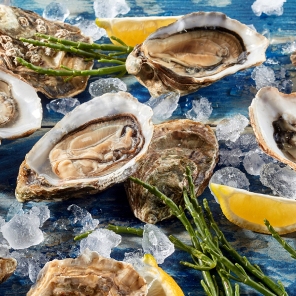
Oysters should be kept cold in a refrigerator until they are cooked or eaten. Unshucked, live oysters should be stored in a bowl or tray with the cup side down and covered with a damp towel to keep them moist. If you have shucked oysters, place them in an airtight container in the fridge at 35-40°F (1-4°C) and consume within 1-2 days for the best flavour and safety.
Disclaimer:At-risk populations (older adults, pregnant women, children aged five and under and people with weakened immune systems) should avoid raw or undercooked oysters. For more information, visitShellfish Food Safety, Government of Canada.
Get inspired!
Oysters have long been considered a delicacy, known for their unique texture and fresh, salty taste that transports you straight to the ocean.
In this guide, we are breaking down everything you need to know about oysters. From how to shuck them like a pro to the different flavour profiles you can expect. Whether you’re a seafood lover or a curious first-timer, our handy tips will help you make the most of your oyster experience.
How to shuck oysters

Shucking oysters can seem tricky at first but with the right tools and technique, it becomes much easier. Follow these simple steps for shucking oysters:
- Prepare your tools:You’ll need an oyster knife and a thick towel or oyster-shucking glove to protect your hand.
- Position the oyster:Wrap the oyster in a towel or wear a glove on the hand holding the oyster. Hold the oyster with the cup side down, making sure the hinge end is pointing towards you.
- Pry open the oyster:Gently work the tip of the knife into the hinge, angling the blade down into the cup of the oyster. Once the knife is in, twist it like you’re turning a key until you hear the hinge pop.
- Cut the muscle:Run the knife along the top inside of the shell to cut the adductor muscle. Lift the top shell away and discard.
- Loosen the oyster:Slide the knife underneath the oyster to loosen it from the shell. Settle the bottom of each shell onto a bed of crushed ice and serve immediately.
What are oysters served with?

Oysters are often served with a variety of accompaniments that subtly help enhance their natural flavours. Some of the most popular items served with oysters include:
- Lemon wedges: This is a classic pairing. The acidity of fresh lemon juice cuts through the richness of oysters, adding a brightness that helps enhance their fresh, salty flavour.
- Mignonette sauce: This simple sauce made from vinegar, shallots and black pepper gives a tangy contrast to the oysters’ brininess.
- Hot sauce: For those who enjoy a bit of heat, hot sauce adds a spicy kick to the oysters.
- Cocktail sauce: This popular option combines ketchup and horseradish for a sweet, spicy and tangy hit.
Different types of oysters

- Irish Point Oysters, Rustico Harbour, PEI: Irish Point is known for their mild and slightly sweet brine with plump meat and a smooth mineral finish.
- ShinySea Oysters, New London Bay, PEI: ShinySea oyster cups are usually full, with plump meats that are briny and fresh with a subtle sweet finish.
- BeauSoleil Cocktail Oysters, Miramichi Bay, New Brunswick: Light and refined, BeauSoleil oysters often feature petite shells with full and firm flesh. They offer a mild brininess with hints of hazelnut and a sweet finish.
- Fresh Choice Malpeque Oysters, Malpeque Bay, PEI: Malpeque oysters are light-bodied with a crisp lettuce-like flavour. They have a sharp briny start and a clean, sweet finish.
- Allseas Oyster Malpeque Oysters, Malpeque Bay, PEI: Malpeque oysters are light-bodied with a crisp lettuce-like flavour. They have a sharp briny start and a clean, sweet finish.
- Lucky Lime Oysters, Hope River, PEI: Citrus and delicate, Lucky Lime has a rustic appearance and a balanced flavour of seaweed & citrus-tone finish.
- Oysters Raspberry Choice, Prince Edward Island National Park, PEI: Raspberries have a high brininess and clean flavour with a delightfully sweet finish.
- Kusshi Oysters in a Shell, Deep Bay, Vancouver Island, BC: Kusshi oysters have meaty flesh and a very clean and delicate flavour.
- French Kiss Oysters, Miramichi Bay, New Brunswick: French Kiss oysters feature full, plump meats that are bold and briny with a mild sweetness on the finish.
How to store oysters

Oysters should be kept cold in a refrigerator until they are cooked or eaten. Unshucked, live oysters should be stored in a bowl or tray with the cup side down and covered with a damp towel to keep them moist. If you have shucked oysters, place them in an airtight container in the fridge at 35-40°F (1-4°C) and consume within 1-2 days for the best flavour and safety.
Disclaimer:At-risk populations (older adults, pregnant women, children aged five and under and people with weakened immune systems) should avoid raw or undercooked oysters. For more information, visitShellfish Food Safety, Government of Canada.
Get inspired!
Oysters have long been considered a delicacy, known for their unique texture and fresh, salty taste that transports you straight to the ocean.
In this guide, we are breaking down everything you need to know about oysters. From how to shuck them like a pro to the different flavour profiles you can expect. Whether you’re a seafood lover or a curious first-timer, our handy tips will help you make the most of your oyster experience.
How to shuck oysters

Shucking oysters can seem tricky at first but with the right tools and technique, it becomes much easier. Follow these simple steps for shucking oysters:
- Prepare your tools:You’ll need an oyster knife and a thick towel or oyster-shucking glove to protect your hand.
- Position the oyster:Wrap the oyster in a towel or wear a glove on the hand holding the oyster. Hold the oyster with the cup side down, making sure the hinge end is pointing towards you.
- Pry open the oyster:Gently work the tip of the knife into the hinge, angling the blade down into the cup of the oyster. Once the knife is in, twist it like you’re turning a key until you hear the hinge pop.
- Cut the muscle:Run the knife along the top inside of the shell to cut the adductor muscle. Lift the top shell away and discard.
- Loosen the oyster:Slide the knife underneath the oyster to loosen it from the shell. Settle the bottom of each shell onto a bed of crushed ice and serve immediately.
What are oysters served with?

Oysters are often served with a variety of accompaniments that subtly help enhance their natural flavours. Some of the most popular items served with oysters include:
- Lemon wedges: This is a classic pairing. The acidity of fresh lemon juice cuts through the richness of oysters, adding a brightness that helps enhance their fresh, salty flavour.
- Mignonette sauce: This simple sauce made from vinegar, shallots and black pepper gives a tangy contrast to the oysters’ brininess.
- Hot sauce: For those who enjoy a bit of heat, hot sauce adds a spicy kick to the oysters.
- Cocktail sauce: This popular option combines ketchup and horseradish for a sweet, spicy and tangy hit.
Different types of oysters

- Irish Point Oysters, Rustico Harbour, PEI: Irish Point is known for their mild and slightly sweet brine with plump meat and a smooth mineral finish.
- ShinySea Oysters, New London Bay, PEI: ShinySea oyster cups are usually full, with plump meats that are briny and fresh with a subtle sweet finish.
- BeauSoleil Cocktail Oysters, Miramichi Bay, New Brunswick: Light and refined, BeauSoleil oysters often feature petite shells with full and firm flesh. They offer a mild brininess with hints of hazelnut and a sweet finish.
- Fresh Choice Malpeque Oysters, Malpeque Bay, PEI: Malpeque oysters are light-bodied with a crisp lettuce-like flavour. They have a sharp briny start and a clean, sweet finish.
- Allseas Oyster Malpeque Oysters, Malpeque Bay, PEI: Malpeque oysters are light-bodied with a crisp lettuce-like flavour. They have a sharp briny start and a clean, sweet finish.
- Lucky Lime Oysters, Hope River, PEI: Citrus and delicate, Lucky Lime has a rustic appearance and a balanced flavour of seaweed & citrus-tone finish.
- Oysters Raspberry Choice, Prince Edward Island National Park, PEI: Raspberries have a high brininess and clean flavour with a delightfully sweet finish.
- Kusshi Oysters in a Shell, Deep Bay, Vancouver Island, BC: Kusshi oysters have meaty flesh and a very clean and delicate flavour.
- French Kiss Oysters, Miramichi Bay, New Brunswick: French Kiss oysters feature full, plump meats that are bold and briny with a mild sweetness on the finish.
How to store oysters

Oysters should be kept cold in a refrigerator until they are cooked or eaten. Unshucked, live oysters should be stored in a bowl or tray with the cup side down and covered with a damp towel to keep them moist. If you have shucked oysters, place them in an airtight container in the fridge at 35-40°F (1-4°C) and consume within 1-2 days for the best flavour and safety.
Disclaimer:At-risk populations (older adults, pregnant women, children aged five and under and people with weakened immune systems) should avoid raw or undercooked oysters. For more information, visitShellfish Food Safety, Government of Canada.
Get inspired!
Oysters have long been considered a delicacy, known for their unique texture and fresh, salty taste that transports you straight to the ocean.
In this guide, we are breaking down everything you need to know about oysters. From how to shuck them like a pro to the different flavour profiles you can expect. Whether you’re a seafood lover or a curious first-timer, our handy tips will help you make the most of your oyster experience.
How to shuck oysters

Shucking oysters can seem tricky at first but with the right tools and technique, it becomes much easier. Follow these simple steps for shucking oysters:
- Prepare your tools:You’ll need an oyster knife and a thick towel or oyster-shucking glove to protect your hand.
- Position the oyster:Wrap the oyster in a towel or wear a glove on the hand holding the oyster. Hold the oyster with the cup side down, making sure the hinge end is pointing towards you.
- Pry open the oyster:Gently work the tip of the knife into the hinge, angling the blade down into the cup of the oyster. Once the knife is in, twist it like you’re turning a key until you hear the hinge pop.
- Cut the muscle:Run the knife along the top inside of the shell to cut the adductor muscle. Lift the top shell away and discard.
- Loosen the oyster:Slide the knife underneath the oyster to loosen it from the shell. Settle the bottom of each shell onto a bed of crushed ice and serve immediately.
What are oysters served with?

Oysters are often served with a variety of accompaniments that subtly help enhance their natural flavours. Some of the most popular items served with oysters include:
- Lemon wedges: This is a classic pairing. The acidity of fresh lemon juice cuts through the richness of oysters, adding a brightness that helps enhance their fresh, salty flavour.
- Mignonette sauce: This simple sauce made from vinegar, shallots and black pepper gives a tangy contrast to the oysters’ brininess.
- Hot sauce: For those who enjoy a bit of heat, hot sauce adds a spicy kick to the oysters.
- Cocktail sauce: This popular option combines ketchup and horseradish for a sweet, spicy and tangy hit.
Different types of oysters

- Irish Point Oysters, Rustico Harbour, PEI: Irish Point is known for their mild and slightly sweet brine with plump meat and a smooth mineral finish.
- ShinySea Oysters, New London Bay, PEI: ShinySea oyster cups are usually full, with plump meats that are briny and fresh with a subtle sweet finish.
- BeauSoleil Cocktail Oysters, Miramichi Bay, New Brunswick: Light and refined, BeauSoleil oysters often feature petite shells with full and firm flesh. They offer a mild brininess with hints of hazelnut and a sweet finish.
- Fresh Choice Malpeque Oysters, Malpeque Bay, PEI: Malpeque oysters are light-bodied with a crisp lettuce-like flavour. They have a sharp briny start and a clean, sweet finish.
- Allseas Oyster Malpeque Oysters, Malpeque Bay, PEI: Malpeque oysters are light-bodied with a crisp lettuce-like flavour. They have a sharp briny start and a clean, sweet finish.
- Lucky Lime Oysters, Hope River, PEI: Citrus and delicate, Lucky Lime has a rustic appearance and a balanced flavour of seaweed & citrus-tone finish.
- Oysters Raspberry Choice, Prince Edward Island National Park, PEI: Raspberries have a high brininess and clean flavour with a delightfully sweet finish.
- Kusshi Oysters in a Shell, Deep Bay, Vancouver Island, BC: Kusshi oysters have meaty flesh and a very clean and delicate flavour.
- French Kiss Oysters, Miramichi Bay, New Brunswick: French Kiss oysters feature full, plump meats that are bold and briny with a mild sweetness on the finish.
How to store oysters

Oysters should be kept cold in a refrigerator until they are cooked or eaten. Unshucked, live oysters should be stored in a bowl or tray with the cup side down and covered with a damp towel to keep them moist. If you have shucked oysters, place them in an airtight container in the fridge at 35-40°F (1-4°C) and consume within 1-2 days for the best flavour and safety.
Disclaimer:At-risk populations (older adults, pregnant women, children aged five and under and people with weakened immune systems) should avoid raw or undercooked oysters. For more information, visitShellfish Food Safety, Government of Canada.
Get inspired!
Oysters have long been considered a delicacy, known for their unique texture and fresh, salty taste that transports you straight to the ocean. We take pride in offering sustainable and Ocean Wise friendly oysters.
In this guide, we are breaking down everything you need to know about oysters. From how to shuck them like a pro to the different flavour profiles you can expect. Whether you’re a seafood lover or a curious first-timer, our handy tips will help you make the most of your oyster experience.
How to shuck oysters

Shucking oysters can seem tricky at first but with the right tools and technique, it becomes much easier. Follow these simple steps for shucking oysters:
- Prepare your tools: You’ll need an oyster knife and a thick towel or oyster-shucking glove to protect your hand.
- Position the oyster: Wrap the oyster in a towel or wear a glove on the hand holding the oyster. Hold the oyster with the cup side down, making sure the hinge end is pointing towards you.
- Pry open the oyster: Gently work the tip of the knife into the hinge, angling the blade down into the cup of the oyster. Once the knife is in, twist it like you’re turning a key until you hear the hinge pop.
- Cut the muscle: Run the knife along the top inside of the shell to cut the adductor muscle. Lift the top shell away and discard.
- Loosen the oyster: Slide the knife underneath the oyster to loosen it from the shell. Settle the bottom of each shell onto a bed of crushed ice and serve immediately.
What are oysters served with?

Oysters are often served with a variety of accompaniments that subtly help enhance their natural flavours. Some of the most popular items served with oysters include:
- Lemon wedges: This is a classic pairing. The acidity of fresh lemon juice cuts through the richness of oysters, adding a brightness that helps enhance their fresh, salty flavour.
- Mignonette sauce: This simple sauce made from vinegar, shallots and black pepper gives a tangy contrast to the oysters’ brininess.
- Hot sauce: For those who enjoy a bit of heat, hot sauce adds a spicy kick to the oysters.
- Cocktail sauce: This popular option combines ketchup and horseradish for a sweet, spicy and tangy hit.
Different types of oysters

- Irish Point Oysters, Rustico Harbour, PEI: Irish Point is known for their mild and slightly sweet brine with plump meat and a smooth mineral finish.
- ShinySea Oysters, New London Bay, PEI: ShinySea oyster cups are usually full, with plump meats that are briny and fresh with a subtle sweet finish.
- BeauSoleil Cocktail Oysters, Miramichi Bay, New Brunswick: Light and refined, BeauSoleil oysters often feature petite shells with full and firm flesh. They offer a mild brininess with hints of hazelnut and a sweet finish.
- Fresh Choice Malpeque Oysters, Malpeque Bay, PEI: Malpeque oysters are light-bodied with a crisp lettuce-like flavour. They have a sharp briny start and a clean, sweet finish.
- Allseas Oyster Malpeque Oysters, Malpeque Bay, PEI: Malpeque oysters are light-bodied with a crisp lettuce-like flavour. They have a sharp briny start and a clean, sweet finish.
- Lucky Lime Oysters, Hope River, PEI: Citrus and delicate, Lucky Lime has a rustic appearance and a balanced flavour of seaweed & citrus-tone finish.
- Oysters Raspberry Choice, Prince Edward Island National Park, PEI: Raspberries have a high brininess and clean flavour with a delightfully sweet finish.
- Kusshi Oysters in a Shell, Deep Bay, Vancouver Island, BC: Kusshi oysters have meaty flesh and a very clean and delicate flavour.
- French Kiss Oysters, Miramichi Bay, New Brunswick: French Kiss oysters feature full, plump meats that are bold and briny with a mild sweetness on the finish.
How to store oysters

Oysters should be kept cold in a refrigerator until they are cooked or eaten. Unshucked, live oysters should be stored in a bowl or tray with the cup side down and covered with a damp towel to keep them moist. If you have shucked oysters, place them in an airtight container in the fridge at 35-40°F (1-4°C) and consume within 1-2 days for the best flavour and safety.
Disclaimer:
At-risk populations (older adults, pregnant women, children aged five and under and people with weakened immune systems) should avoid raw or undercooked oysters. For more information, visit Shellfish Food Safety, Government of Canada.
Get inspired!
Oysters have long been considered a delicacy, known for their unique texture and fresh, salty taste that transports you straight to the ocean.
In this guide, we are breaking down everything you need to know about oysters. From how to shuck them like a pro to the different flavour profiles you can expect. Whether you’re a seafood lover or a curious first-timer, our handy tips will help you make the most of your oyster experience.
How to shuck oysters

Shucking oysters can seem tricky at first but with the right tools and technique, it becomes much easier. Follow these simple steps for shucking oysters:
- Prepare your tools:You’ll need an oyster knife and a thick towel or oyster-shucking glove to protect your hand.
- Position the oyster:Wrap the oyster in a towel or wear a glove on the hand holding the oyster. Hold the oyster with the cup side down, making sure the hinge end is pointing towards you.
- Pry open the oyster:Gently work the tip of the knife into the hinge, angling the blade down into the cup of the oyster. Once the knife is in, twist it like you’re turning a key until you hear the hinge pop.
- Cut the muscle:Run the knife along the top inside of the shell to cut the adductor muscle. Lift the top shell away and discard.
- Loosen the oyster:Slide the knife underneath the oyster to loosen it from the shell. Settle the bottom of each shell onto a bed of crushed ice and serve immediately.
What are oysters served with?

Oysters are often served with a variety of accompaniments that subtly help enhance their natural flavours. Some of the most popular items served with oysters include:
- Lemon wedges: This is a classic pairing. The acidity of fresh lemon juice cuts through the richness of oysters, adding a brightness that helps enhance their fresh, salty flavour.
- Mignonette sauce: This simple sauce made from vinegar, shallots and black pepper gives a tangy contrast to the oysters’ brininess.
- Hot sauce: For those who enjoy a bit of heat, hot sauce adds a spicy kick to the oysters.
- Cocktail sauce: This popular option combines ketchup and horseradish for a sweet, spicy and tangy hit.
Different types of oysters

- Irish Point Oysters, Rustico Harbour, PEI: Irish Point is known for their mild and slightly sweet brine with plump meat and a smooth mineral finish.
- ShinySea Oysters, New London Bay, PEI: ShinySea oyster cups are usually full, with plump meats that are briny and fresh with a subtle sweet finish.
- BeauSoleil Cocktail Oysters, Miramichi Bay, New Brunswick: Light and refined, BeauSoleil oysters often feature petite shells with full and firm flesh. They offer a mild brininess with hints of hazelnut and a sweet finish.
- Fresh Choice Malpeque Oysters, Malpeque Bay, PEI: Malpeque oysters are light-bodied with a crisp lettuce-like flavour. They have a sharp briny start and a clean, sweet finish.
- Allseas Oyster Malpeque Oysters, Malpeque Bay, PEI: Malpeque oysters are light-bodied with a crisp lettuce-like flavour. They have a sharp briny start and a clean, sweet finish.
- Lucky Lime Oysters, Hope River, PEI: Citrus and delicate, Lucky Lime has a rustic appearance and a balanced flavour of seaweed & citrus-tone finish.
- Oysters Raspberry Choice, Prince Edward Island National Park, PEI: Raspberries have a high brininess and clean flavour with a delightfully sweet finish.
- Kusshi Oysters in a Shell, Deep Bay, Vancouver Island, BC: Kusshi oysters have meaty flesh and a very clean and delicate flavour.
- French Kiss Oysters, Miramichi Bay, New Brunswick: French Kiss oysters feature full, plump meats that are bold and briny with a mild sweetness on the finish.
How to store oysters

Oysters should be kept cold in a refrigerator until they are cooked or eaten. Unshucked, live oysters should be stored in a bowl or tray with the cup side down and covered with a damp towel to keep them moist. If you have shucked oysters, place them in an airtight container in the fridge at 35-40°F (1-4°C) and consume within 1-2 days for the best flavour and safety.
Disclaimer:At-risk populations (older adults, pregnant women, children aged five and under and people with weakened immune systems) should avoid raw or undercooked oysters. For more information, visitShellfish Food Safety, Government of Canada.
Get inspired!
Oysters have long been considered a delicacy, known for their unique texture and fresh, salty taste that transports you straight to the ocean.
In this guide, we are breaking down everything you need to know about oysters. From how to shuck them like a pro to the different flavour profiles you can expect. Whether you’re a seafood lover or a curious first-timer, our handy tips will help you make the most of your oyster experience.
How to shuck oysters

Shucking oysters can seem tricky at first but with the right tools and technique, it becomes much easier. Follow these simple steps for shucking oysters:
- Prepare your tools:You’ll need an oyster knife and a thick towel or oyster-shucking glove to protect your hand.
- Position the oyster:Wrap the oyster in a towel or wear a glove on the hand holding the oyster. Hold the oyster with the cup side down, making sure the hinge end is pointing towards you.
- Pry open the oyster:Gently work the tip of the knife into the hinge, angling the blade down into the cup of the oyster. Once the knife is in, twist it like you’re turning a key until you hear the hinge pop.
- Cut the muscle:Run the knife along the top inside of the shell to cut the adductor muscle. Lift the top shell away and discard.
- Loosen the oyster:Slide the knife underneath the oyster to loosen it from the shell. Settle the bottom of each shell onto a bed of crushed ice and serve immediately.
What are oysters served with?

Oysters are often served with a variety of accompaniments that subtly help enhance their natural flavours. Some of the most popular items served with oysters include:
- Lemon wedges: This is a classic pairing. The acidity of fresh lemon juice cuts through the richness of oysters, adding a brightness that helps enhance their fresh, salty flavour.
- Mignonette sauce: This simple sauce made from vinegar, shallots and black pepper gives a tangy contrast to the oysters’ brininess.
- Hot sauce: For those who enjoy a bit of heat, hot sauce adds a spicy kick to the oysters.
- Cocktail sauce: This popular option combines ketchup and horseradish for a sweet, spicy and tangy hit.
Different types of oysters

- Irish Point Oysters, Rustico Harbour, PEI: Irish Point is known for their mild and slightly sweet brine with plump meat and a smooth mineral finish.
- ShinySea Oysters, New London Bay, PEI: ShinySea oyster cups are usually full, with plump meats that are briny and fresh with a subtle sweet finish.
- BeauSoleil Cocktail Oysters, Miramichi Bay, New Brunswick: Light and refined, BeauSoleil oysters often feature petite shells with full and firm flesh. They offer a mild brininess with hints of hazelnut and a sweet finish.
- Fresh Choice Malpeque Oysters, Malpeque Bay, PEI: Malpeque oysters are light-bodied with a crisp lettuce-like flavour. They have a sharp briny start and a clean, sweet finish.
- Allseas Oyster Malpeque Oysters, Malpeque Bay, PEI: Malpeque oysters are light-bodied with a crisp lettuce-like flavour. They have a sharp briny start and a clean, sweet finish.
- Lucky Lime Oysters, Hope River, PEI: Citrus and delicate, Lucky Lime has a rustic appearance and a balanced flavour of seaweed & citrus-tone finish.
- Oysters Raspberry Choice, Prince Edward Island National Park, PEI: Raspberries have a high brininess and clean flavour with a delightfully sweet finish.
- Kusshi Oysters in a Shell, Deep Bay, Vancouver Island, BC: Kusshi oysters have meaty flesh and a very clean and delicate flavour.
- French Kiss Oysters, Miramichi Bay, New Brunswick: French Kiss oysters feature full, plump meats that are bold and briny with a mild sweetness on the finish.
How to store oysters

Oysters should be kept cold in a refrigerator until they are cooked or eaten. Unshucked, live oysters should be stored in a bowl or tray with the cup side down and covered with a damp towel to keep them moist. If you have shucked oysters, place them in an airtight container in the fridge at 35-40°F (1-4°C) and consume within 1-2 days for the best flavour and safety.
Disclaimer:At-risk populations (older adults, pregnant women, children aged five and under and people with weakened immune systems) should avoid raw or undercooked oysters. For more information, visitShellfish Food Safety, Government of Canada.
Get inspired!
Oysters have long been considered a delicacy, known for their unique texture and fresh, salty taste that transports you straight to the ocean.
In this guide, we are breaking down everything you need to know about oysters. From how to shuck them like a pro to the different flavour profiles you can expect. Whether you’re a seafood lover or a curious first-timer, our handy tips will help you make the most of your oyster experience.
How to shuck oysters

Shucking oysters can seem tricky at first but with the right tools and technique, it becomes much easier. Follow these simple steps for shucking oysters:
- Prepare your tools:You’ll need an oyster knife and a thick towel or oyster-shucking glove to protect your hand.
- Position the oyster:Wrap the oyster in a towel or wear a glove on the hand holding the oyster. Hold the oyster with the cup side down, making sure the hinge end is pointing towards you.
- Pry open the oyster:Gently work the tip of the knife into the hinge, angling the blade down into the cup of the oyster. Once the knife is in, twist it like you’re turning a key until you hear the hinge pop.
- Cut the muscle:Run the knife along the top inside of the shell to cut the adductor muscle. Lift the top shell away and discard.
- Loosen the oyster:Slide the knife underneath the oyster to loosen it from the shell. Settle the bottom of each shell onto a bed of crushed ice and serve immediately.
What are oysters served with?

Oysters are often served with a variety of accompaniments that subtly help enhance their natural flavours. Some of the most popular items served with oysters include:
- Lemon wedges: This is a classic pairing. The acidity of fresh lemon juice cuts through the richness of oysters, adding a brightness that helps enhance their fresh, salty flavour.
- Mignonette sauce: This simple sauce made from vinegar, shallots and black pepper gives a tangy contrast to the oysters’ brininess.
- Hot sauce: For those who enjoy a bit of heat, hot sauce adds a spicy kick to the oysters.
- Cocktail sauce: This popular option combines ketchup and horseradish for a sweet, spicy and tangy hit.
Different types of oysters

- Irish Point Oysters, Rustico Harbour, PEI: Irish Point is known for their mild and slightly sweet brine with plump meat and a smooth mineral finish.
- ShinySea Oysters, New London Bay, PEI: ShinySea oyster cups are usually full, with plump meats that are briny and fresh with a subtle sweet finish.
- BeauSoleil Cocktail Oysters, Miramichi Bay, New Brunswick: Light and refined, BeauSoleil oysters often feature petite shells with full and firm flesh. They offer a mild brininess with hints of hazelnut and a sweet finish.
- Fresh Choice Malpeque Oysters, Malpeque Bay, PEI: Malpeque oysters are light-bodied with a crisp lettuce-like flavour. They have a sharp briny start and a clean, sweet finish.
- Allseas Oyster Malpeque Oysters, Malpeque Bay, PEI: Malpeque oysters are light-bodied with a crisp lettuce-like flavour. They have a sharp briny start and a clean, sweet finish.
- Lucky Lime Oysters, Hope River, PEI: Citrus and delicate, Lucky Lime has a rustic appearance and a balanced flavour of seaweed & citrus-tone finish.
- Oysters Raspberry Choice, Prince Edward Island National Park, PEI: Raspberries have a high brininess and clean flavour with a delightfully sweet finish.
- Kusshi Oysters in a Shell, Deep Bay, Vancouver Island, BC: Kusshi oysters have meaty flesh and a very clean and delicate flavour.
- French Kiss Oysters, Miramichi Bay, New Brunswick: French Kiss oysters feature full, plump meats that are bold and briny with a mild sweetness on the finish.
How to store oysters

Oysters should be kept cold in a refrigerator until they are cooked or eaten. Unshucked, live oysters should be stored in a bowl or tray with the cup side down and covered with a damp towel to keep them moist. If you have shucked oysters, place them in an airtight container in the fridge at 35-40°F (1-4°C) and consume within 1-2 days for the best flavour and safety.
Disclaimer:At-risk populations (older adults, pregnant women, children aged five and under and people with weakened immune systems) should avoid raw or undercooked oysters. For more information, visitShellfish Food Safety, Government of Canada.
Get inspired!
Oysters have long been considered a delicacy, known for their unique texture and fresh, salty taste that transports you straight to the ocean.
In this guide, we are breaking down everything you need to know about oysters. From how to shuck them like a pro to the different flavour profiles you can expect. Whether you’re a seafood lover or a curious first-timer, our handy tips will help you make the most of your oyster experience.
How to shuck oysters

Shucking oysters can seem tricky at first but with the right tools and technique, it becomes much easier. Follow these simple steps for shucking oysters:
- Prepare your tools:You’ll need an oyster knife and a thick towel or oyster-shucking glove to protect your hand.
- Position the oyster:Wrap the oyster in a towel or wear a glove on the hand holding the oyster. Hold the oyster with the cup side down, making sure the hinge end is pointing towards you.
- Pry open the oyster:Gently work the tip of the knife into the hinge, angling the blade down into the cup of the oyster. Once the knife is in, twist it like you’re turning a key until you hear the hinge pop.
- Cut the muscle:Run the knife along the top inside of the shell to cut the adductor muscle. Lift the top shell away and discard.
- Loosen the oyster:Slide the knife underneath the oyster to loosen it from the shell. Settle the bottom of each shell onto a bed of crushed ice and serve immediately.
What are oysters served with?

Oysters are often served with a variety of accompaniments that subtly help enhance their natural flavours. Some of the most popular items served with oysters include:
- Lemon wedges: This is a classic pairing. The acidity of fresh lemon juice cuts through the richness of oysters, adding a brightness that helps enhance their fresh, salty flavour.
- Mignonette sauce: This simple sauce made from vinegar, shallots and black pepper gives a tangy contrast to the oysters’ brininess.
- Hot sauce: For those who enjoy a bit of heat, hot sauce adds a spicy kick to the oysters.
- Cocktail sauce: This popular option combines ketchup and horseradish for a sweet, spicy and tangy hit.
Different types of oysters

- Irish Point Oysters, Rustico Harbour, PEI: Irish Point is known for their mild and slightly sweet brine with plump meat and a smooth mineral finish.
- ShinySea Oysters, New London Bay, PEI: ShinySea oyster cups are usually full, with plump meats that are briny and fresh with a subtle sweet finish.
- BeauSoleil Cocktail Oysters, Miramichi Bay, New Brunswick: Light and refined, BeauSoleil oysters often feature petite shells with full and firm flesh. They offer a mild brininess with hints of hazelnut and a sweet finish.
- Fresh Choice Malpeque Oysters, Malpeque Bay, PEI: Malpeque oysters are light-bodied with a crisp lettuce-like flavour. They have a sharp briny start and a clean, sweet finish.
- Allseas Oyster Malpeque Oysters, Malpeque Bay, PEI: Malpeque oysters are light-bodied with a crisp lettuce-like flavour. They have a sharp briny start and a clean, sweet finish.
- Lucky Lime Oysters, Hope River, PEI: Citrus and delicate, Lucky Lime has a rustic appearance and a balanced flavour of seaweed & citrus-tone finish.
- Oysters Raspberry Choice, Prince Edward Island National Park, PEI: Raspberries have a high brininess and clean flavour with a delightfully sweet finish.
- Kusshi Oysters in a Shell, Deep Bay, Vancouver Island, BC: Kusshi oysters have meaty flesh and a very clean and delicate flavour.
- French Kiss Oysters, Miramichi Bay, New Brunswick: French Kiss oysters feature full, plump meats that are bold and briny with a mild sweetness on the finish.
How to store oysters

Oysters should be kept cold in a refrigerator until they are cooked or eaten. Unshucked, live oysters should be stored in a bowl or tray with the cup side down and covered with a damp towel to keep them moist. If you have shucked oysters, place them in an airtight container in the fridge at 35-40°F (1-4°C) and consume within 1-2 days for the best flavour and safety.
Disclaimer:At-risk populations (older adults, pregnant women, children aged five and under and people with weakened immune systems) should avoid raw or undercooked oysters. For more information, visitShellfish Food Safety, Government of Canada.

